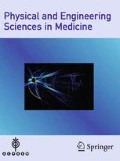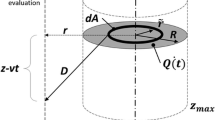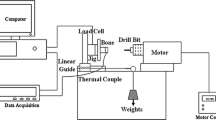Abstract
Bone drilling is an important procedure in medical orthopedic surgery and it is inevitable that heat will be generated during the drilling process and higher temperatures can cause thermal damage to the bone tissue near the drilled hole. Therefore, the capability to obtain the cortical bone drilling temperature distribution area can have great significance for medical bone surgery. Based on the theory of heat transfer, a predictive model for cortical bone drilling temperature distribution was established. The energy distribution coefficient in cortical bone drilling was derived, based on conjugate gradient inversion. A cortical bone drilling experiment platform was built to verify the temperature distribution prediction model. The results show that the model of cortical bone drill temperature distribution could predict accurately the drilling temperature distribution, both for different depths and for different radial distances. Additionally, the effects of different drilling conditions (spindle speed, feed rate, drill diameter) on the temperature of drilling cortical bone were considered.









Similar content being viewed by others
References
Augustin G, Davila S, Udilljak T et al (2012) Temperature changes during cortical bone drilling with a newly designed step drill and an internally cooled dril l [J]. Int Orthop 36(7):1449
Ke X, Qun X, Lin-hong JI et al (2009) Influence of a minimally invasive bone drill cutting parameters on cutting forces and temperature [J]. Mach Des Manuf (2):264–266
QingYun Z (2014) Finite element analysis and experimental research of cortical bone drilling performance based on ABAQUS [D]. Tianjin University of Technology, Tianjin
Eriksson AR, Albrektsson T, Grane B, McQueen D (1983) Thermal injury to bone. A vital-microscopic description of heat effects [J]. Int J Oral Surg 11:115–121
Eriksson R, Albrektsson T (1983) Temperature threshold levels for heat-induced bone tissue injury: a vital-microscopic study in the rabbit [J]. J Prosthetic Dent 50:101–107
Allan W, Williams ED, Kerawala CJ (2005) Effects of repeated drill use on temperature of bone during preparation for osteosynthesis self-tapping screws [J]. Br J Oral Maxillofac Surg 43:314–319
Matthes M, Pillich DT, El Refaee E (2018) Heat generation during bony decompression of lumbar spinal stenosis using a high-speed diamond drill with or without automated irrigation and an ultrasonic bone-cutting knife: a single-blinded prospective randomized controlled study [J]. World Neurosurg 111:72–81
Shakouri E, Ghorbani M (2020) Nezhad. An in vitro study of bone drilling: infrared thermography and evaluation of thermal changes of bone and drill bit [J]. Phys Eng Sci Med 43(1):247–257
Shakouri E, Mirfallah P (2019) Infrared thermography of high-speed grinding of bone in skull base neurosurgery [J]. Proc Inst Mech Eng Part H: J Eng Med 233(6):648–656
Shakouri E, Nezhad MG, Ghorbani P, Khosravi-Nejad F (2020) Investigation of thermal aspects of high-speed drilling of bone by theoretical and experimental approaches [J]. Phys Eng Sci Med (prepublish)
Omar NA, McKinley JC (2018) Measurement of temperature induced in bone during drilling in minimally invasive foot surgery [J]. Foot 35:63–69
Aleksa M, Zoran L, Tijana M et al (2016) Effect of surgical drill guide and irrigans temperature on thermal bone changes during drilling implant sites: thermographic analysis on bovine ribs [J]. Hum Vet Med 73(8):744–750
Gupta V, Pandey PM, Mridha AR (2017) Effect of various parameters on the temperature distribution in conventional and diamond coated hollow tool bone drilling: a comparative study [J]. Procedia Eng (04):74
Wu J, Han RD (2009) A new approach to predicting the maximum temperature in dry drilling based on a finite element model [J]. Manuf Process 11:19–30
Ozcelik B, Bagci E (2006) Experimental and numerical studies on the determination of twist drill temperature in dry drilling: a new approach [J]. Mater Des 27:920–927
Bagci E, Ozcelik B (2006) Finite element and experimental investigation of temperature changes on a twist drill in sequentialdry drilling [J]. Int J Adv Manuf Technol 28:680–687
Heydari H, Kazerooni NC, Zolfaghari M (2018) Analytical and experimental study of effective parameters on process temperature during cortical bone drilling [J]. J Eng Med 232(9):871–883
Shakouri E, Sadeghi MH, Maerefat M (2014) Experimental and analytical investigation of the thermal necrosis in high-speed drilling of bone [J]. J Eng Med 228(4):330–341
Tu Y-K, Tsai H-H et al (2008) Finite element simulation of drill bit and bone thermal contact during drilling [J]. Int Conf Bioinform Biomed Eng (08):1268–1271
Jian W (2010) Basic research on the related technoligies of drilling typical difficult-to-machine materials [D]. Harbin Institute of Technology, Harbin
Li Jian, Li Yuan, Zhang Kai Fu, et al (2016) Research on temperature distribution in drilling of CFRP/Tistacks [D]
Tauscher S, Fuchs A, Baier F, Kahrs LA, Ortmaier T (2017) High-accuracy drilling with an image guided light weight robot: autonomous versus intuitive feed control [J]. Int J Comput Assist Radiol Surg 12(10):1763–1773
RiYao C (2005) Principles of metal cutting [M], 2nd edn. Mechanical Industry Press, Beijing, pp 1–228
Ramulu M (1997) Machining and surface integrity of fibre-reinforced plastic composites [J]. Sadhana 22(3):449–472
Amewoui F, Le Coz G, Bonnet A-S, Moufki A (2020) An analytical modeling with experimental validation of bone temperature rise in drilling process [J]. Med Eng Phys 84:151–160
Hu HP (2010) Heat conduction theory [M]. China Science and Technology Press, AnHui, pp 9–250
Zhu GuoPing (2013) Study on drilling temperature field of unidirectional carbon/epoxy composites [D]
Hong Tan W (2005) Application of conjugate gradient method to two-dimensional inverse convective heat transfer problem [J]. J Astron Metrol Measure (04):25–27 +40
Miller ER, Ullrey DE (1987) The pig as a model for human nutrition [J]. Annu Rev Nutr 7:361–382
Nazanin M, Kambiz F, Mohammad H (2014) A model for the prediction of thermal response of bone in surgical drilling [J]. J Thermal Sci Eng Appl 6(4):041005
JuEun L, Yoed R, Burak OO (2011) A new thermal model for bone drilling with applications to orthopaedic surgery [J]. Med Eng Phys 33(10):1234–1244
Alam K, Hassan E, Bahadur I (2015) Experimental measurements of temperatures in ultrasonically assisted drilling of corticalbone [J]. Biotechnol Biotechnol Equip 29:753–757
Gupta V, Pandey PM, Mridh AR, Gupta RK (2017) Effect of various parameters on the temperature distribution in conventional and diamond coated hollow tool bone drilling: a comparative study [J]. Procedia Eng 184:90–98
Funding
This study was funded by the Key Fund of Tianjin Natural Science Foundation of China (Grant No.15JCZDJC32800) and the National Natural Science Foundation of China (Grant No.11672208, Grant No.81741141).
Author information
Authors and Affiliations
Corresponding author
Ethics declarations
Conflict of interest
The author(s) declared no potential conficts of interest with respect to the research, authorship, and/or publication of this article.
Ethical approval
This article does not contain any studies with human participants or animals performed by any of the authors.
Informed consent
Informed consent was obtained from all individual participants included in the study.
Additional information
Publisher's Note
Springer Nature remains neutral with regard to jurisdictional claims in published maps and institutional affiliations.
Rights and permissions
About this article
Cite this article
Hu, Y., Ding, H., Shi, Y. et al. A predictive model for cortical bone temperature distribution during drilling. Phys Eng Sci Med 44, 147–156 (2021). https://doi.org/10.1007/s13246-020-00962-4
Received:
Accepted:
Published:
Issue Date:
DOI: https://doi.org/10.1007/s13246-020-00962-4




